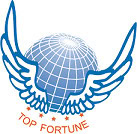Top Tips for Customizing Store Uniforms with Your Brand Logo
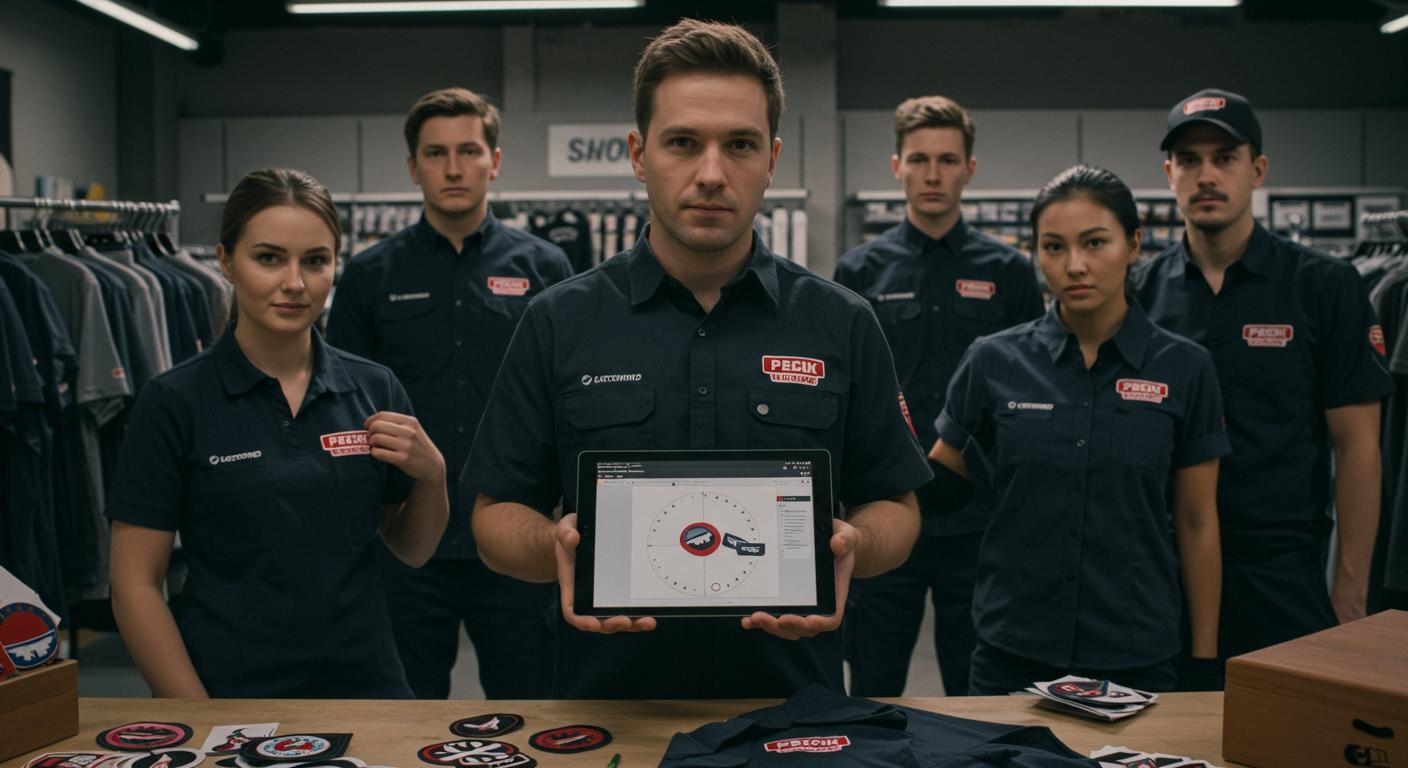
When I help clients elevate their store uniforms, I notice how a clear logo instantly boosts both brand recognition and team morale. Studies show that:
Branded uniforms foster collective identity, enhance customer trust, and make staff easy to identify.
I always advise considering your branding goals and the preferences of those who will wear the uniform. The right logo placement turns everyday workwear into a symbol of professionalism and unity.
Key Takeaways
Branded uniforms enhance brand recognition and trust. 60% of consumers trust businesses more when staff wear branded apparel.
Define your branding goals before customizing uniforms. Consider visibility, team spirit, and customer trust to guide your design choices.
Employee comfort is crucial. Survey staff about fabric, fit, and color preferences to boost morale and performance.
Keep uniform designs simple. A clear logo and uncluttered look make uniforms more professional and recognizable.
Choose the right logo placement for maximum visibility. Front and back placements are most effective for brand recognition.
Invest in quality materials for durability. High-quality fabrics reduce replacement costs and maintain a professional appearance.
Involve employees in the design process. Their input fosters pride and satisfaction, leading to better team spirit.
Consider seasonal uniforms and accessories. They enhance comfort and professionalism while reinforcing brand identity.
Store Uniforms Strategy
Branding Goals
When I consult with clients about store uniforms, I always start by clarifying their branding objectives. A clear purpose guides every decision, from color selection to logo placement. Many businesses want uniforms to do more than just look professional. They want them to serve as mobile billboards, foster team spirit, and build customer trust. I often share this table to help clients define their goals:
Branding Objective | Description |
|---|---|
Enhancing Brand Visibility | Uniforms act as mobile billboards, promoting the brand whenever employees wear them outside. |
Fostering Team Spirit | Uniforms create a sense of unity and pride among employees, reinforcing their connection to the brand. |
Building Customer Trust | Branded clothing helps customers identify employees as part of a reputable organization, enhancing trust. |
Affordable Marketing Tool | Compared to other advertising methods, uniforms provide long-term brand promotion at a lower cost. |
I recommend that every store owner consider which of these objectives matter most. This clarity ensures that the branding on store uniforms aligns with the company’s mission and values.
Wearer Preferences
I have learned that employee satisfaction plays a crucial role in the success of any uniform program. When staff feel comfortable and confident, they represent the brand better. For example, in healthcare, nurses often prefer scrubs over traditional white coats. Comfort and professional identity matter. In fact, 83% of nurses choose scrubs for their daily work, and 87% say scrubs feel more comfortable. Color preferences also influence satisfaction. In clinical settings, navy blue and light blue dominate for practicality and calmness, while pink creates a friendly tone in pediatric wards.
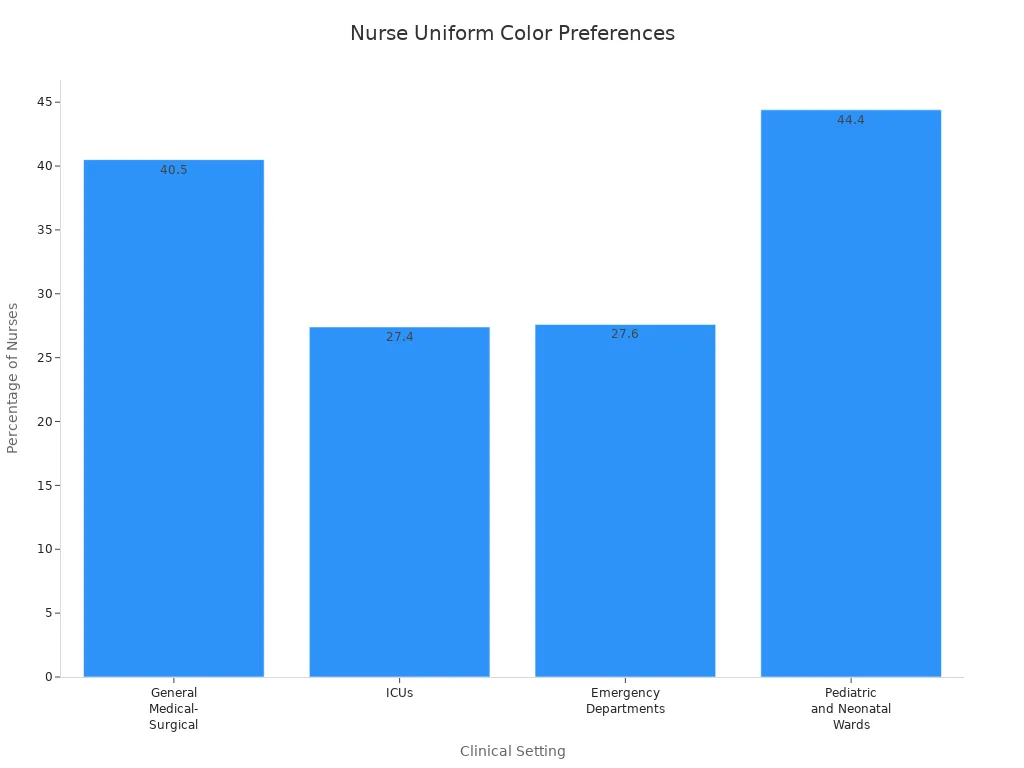
I always encourage store owners to survey their teams about fabric, fit, and color. This approach ensures that store uniforms not only support branding but also boost morale and performance.
Simplicity in Design
Simple designs make the biggest impact. I have seen how uncluttered uniforms with a clear logo stand out and reinforce branding. A visually appealing uniform reflects professionalism and aligns with brand messaging. Color selection matters, too. Blue often signals trustworthiness, red brings excitement, and neutral tones suggest formality. Material choice should match the work environment and brand values. For example, eco-friendly fabrics suit sustainable brands.
A straightforward design helps customers recognize staff quickly. It also keeps the focus on the brand logo, which is the heart of effective store uniforms. I always advise clients to avoid overcrowding uniforms with too many elements. Clean lines and a prominent logo deliver the strongest branding message.
Custom Embroidery Methods
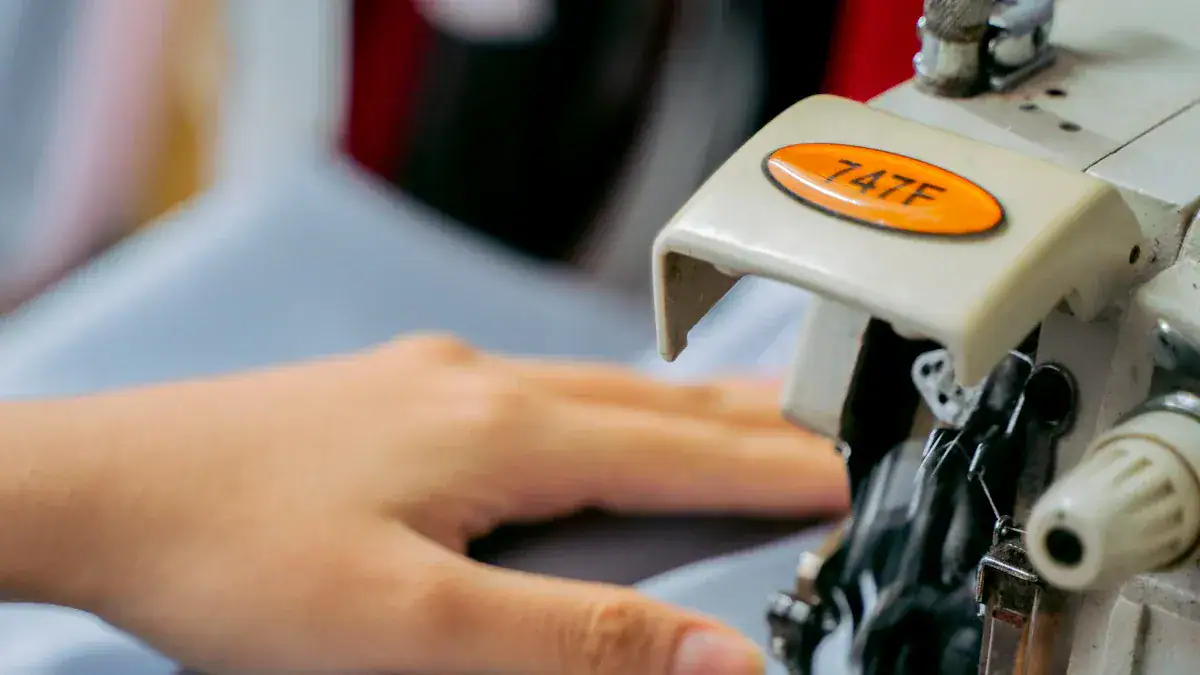
When I help clients choose the right method for adding their brand logo to store uniforms, I always start by comparing the three main options: custom embroidery, printing, and patches. Each method offers unique advantages and challenges. The right choice depends on your branding goals, budget, and the look you want to achieve.
Embroidery
Custom embroidery stands out as the gold standard for durability and a professional appearance. I have seen how embroidery maintains its color and structure even after countless washes. The raised, textured finish of custom embroidery adds a touch of sophistication to any uniform. When I run my hands over a freshly embroidered logo, I can feel the quality and attention to detail. Custom embroidery works best for logos that need to last as long as the garment itself.
I often recommend custom embroidery for businesses that want a classic, timeless look. The tactile feel of custom embroidery makes logos pop, especially on polos, dress shirts, and jackets. Custom embroidery also resists fading and wear, which means uniforms look sharp for years. I have noticed that custom embroidery is ideal for small, bold designs. It gives a dimensional effect that printing cannot match.
Application Method | Durability | Appearance |
|---|---|---|
Embroidery | Extremely durable, lasts the lifetime of the garment, resistant to fading and wear | Classic, timeless look with raised, textured stitching |
Patches (Sew-on) | Highly durable, longevity depends on application and materials | Versatile aesthetics, can be modern or classic |
Printed | May crack or fade over time, durability depends on ink quality | Flat, sleek design, ideal for colorful and detailed graphics |
Custom embroidery offers several types, each with its own advantages:
Embroidery Type | Advantages |
|---|---|
Traditional Embroidery | Creates a dimensional, stitched look; ideal for logos and designs that need durability. |
Direct-to-Garment with Embroidery Accents | Combines vibrant printing with embroidery; suitable for complex logos and fashion-forward items. |
Appliqué Embroidery | Uses cut fabric for texture; great for large designs and athletic uniforms. |
I always advise clients to consider the complexity of their logo. Custom embroidery excels with simple, bold designs. For intricate graphics or gradients, printing might be a better fit. However, nothing beats the longevity and prestige of custom embroidery.
Fabric Compatibility
Choosing the right fabric is crucial for successful custom embroidery. I have learned that matching the fabric with the correct stabilizer and needle ensures the best results. For example, linen offers a tight weave and works well with a sharp needle. Fleece requires a topping stabilizer to prevent the stitches from sinking. Denim, being heavyweight, needs a heavy-duty sharp needle.
Fabric Type | Properties | Stabilizer | Needle |
|---|---|---|---|
Linen | Tight weave, lightweight, durable | Tear-away or cut-away | Sharp needle (size 75–90) |
Fleece | Stretch-resistant, easy to embroider | Cut-away or tear-away, plus a topping stabilizer | Ballpoint or sharp (size 75–90) |
Denim | Heavyweight, rigid | Cut-away or tear-away | Heavy-duty sharp (size 90–100) |
Tip: High-visibility workwear demands careful planning for custom embroidery placement and thread selection. I always ensure compliance with ANSI/ISEA and NFPA standards for safety uniforms. Working with experienced embroidery services guarantees that uniforms meet all safety requirements.
When I work with clients, I follow these steps for the best custom embroidery results:
Match the fabric with the right stabilizer and needle.
Use a cut-away stabilizer and surface topping for stretchy or textured fabrics.
Choose a heavy-duty sharp needle for thick or coarse fabrics.
Custom embroidery requires quality fabrics. I always recommend investing in premium materials to ensure the embroidery holds up over time. Cheap fabrics can lead to puckering or distortion, which undermines the professional look you want.
Printing
Printing offers a different set of advantages for store uniforms. I have found that printing works best for colorful graphics and detailed designs. The flat, integrated look of printing allows for vibrant colors and fine details that custom embroidery cannot always achieve. Screen printing remains a popular choice for t-shirts and lightweight garments.
However, I have noticed that printed logos may crack or fade over time, especially if the ink or fabric quality is low. Unlike custom embroidery, printing does not provide a raised texture. Instead, it delivers a sleek, modern appearance. For businesses that want to showcase intricate artwork or gradients, printing is often the preferred method.
Method | Average Cost Range | Turnaround Time |
|---|---|---|
Embroidery | 2-3 weeks after approval | |
Screen Printing | Starts at $16 per shirt | 2-3 weeks after approval |
Printing offers a faster and more affordable solution for large orders. I often suggest printing for promotional uniforms or seasonal campaigns where longevity is less critical. Still, I remind clients that custom embroidery outlasts printing in terms of durability.
Embroidered logos are more durable and resistant to wear and tear compared to heat seal branding.
Embroidered shirts maintain their appearance over time, even after multiple washes, while heat transfers may fade or peel.
The durability of embroidery often matches the lifespan of the garment itself.
Patches
Patches provide a versatile option for branding store uniforms. I have used both embroidered and woven patches to create unique looks for clients. Embroidered patches offer a classic, textured feel, while woven patches allow for finer detail and a lighter weight.
Feature | Embroidered Patches | Printed Patches |
|---|---|---|
Durability | Long-lasting, resistant to wear and tear | May fade or peel over time |
Design Complexity | Best for simple, bold designs | Allows for intricate designs with gradients |
Type of Patch | Pros | Cons |
|---|---|---|
Embroidered Patches | – Versatile design options | – Bulky design can feel heavy |
– Customizable to convey brand identity effectively | – Higher cost due to production complexity | |
– Popular style that resonates with customers | – Longer turnaround time for production | |
– Limited detail in intricate designs | ||
Woven Patches | – Lightweight and less bulky, suitable for thin fabrics | – One-dimensional design lacks texture |
– Ideal for fine detail and intricate designs | – Less popular, may have lower market appeal | |
– More affordable, cost-effective for larger orders | – Less eye-catching compared to embroidered patches | |
– Faster production time |
I recommend patches for clients who want flexibility. Patches can be sewn or heat-applied, making them easy to replace or update. They work well for uniforms that need frequent changes, such as seasonal staff or temporary promotions. I always remind clients that embroidered patches last longer and resist wear better than printed patches.
Embroidery offers a raised, tactile feel, ideal for small and intricate designs.
Patches can provide a modern or edgy look, with various textures depending on materials used.
Screen printing results in a flat design, perfect for vibrant colors and fine details.
When I guide clients through the decision process, I always weigh the pros and cons of each method. Custom embroidery delivers unmatched durability and a premium look. Printing excels with colorful, detailed graphics. Patches offer flexibility and easy updates. By understanding these differences, I help clients choose the best custom embroidery method for their brand and budget.
Logo Placement
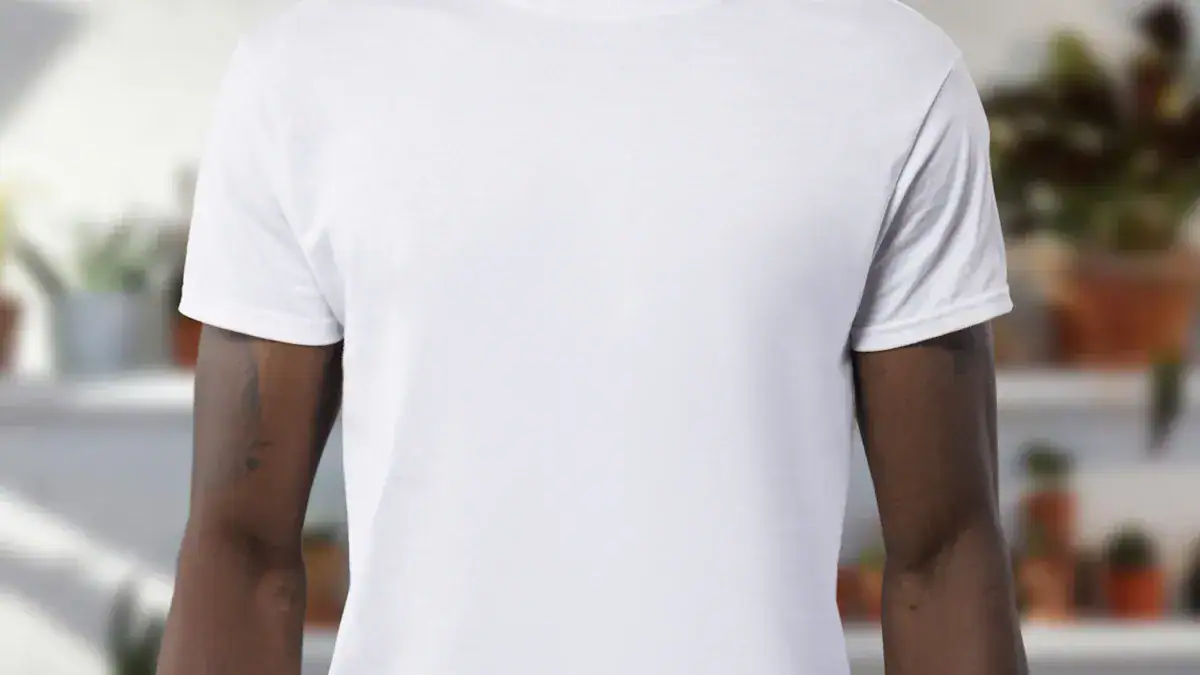
Choosing the right logo placement transforms a uniform from ordinary to a powerful branding tool. I always focus on balanced, visible, and consistent logo placement to maximize both brand recognition and professionalism. The right approach ensures every team member looks unified and represents the brand with confidence.
Front and Back
When I advise clients on logo placement, I start with the front and back of the uniform. These areas offer the most visibility and make the strongest impression on customers. I use a table to help clients visualize the ideal measurements and best uses for each logo placement:
Logo Placement | Ideal Measurements | Best Uses |
|---|---|---|
Left Chest | 3–4 inches below collar, 4–6 inches from centerline, 2.5–5 inches wide | Corporate uniforms, volunteer shirts, minimalist logos |
Center Chest | 2–4 inches below collar, centered, 6–10 inches wide | Event tees, promotional wear, statement graphics |
Full Front and Back | 10–14 inches wide and high, 3 inches down from neckline | Event promotions, artistic statements, large graphics |
I recommend placing the logo on the left chest for a classic, professional look. This logo placement feels natural and keeps the design close to the heart, which adds a subtle touch of professionalism. For event uniforms or promotional wear, a center chest logo placement stands out and draws attention. When clients want to make a bold statement, I suggest full front or back logo placement. This approach works well for large graphics and ensures the logo is visible from a distance.
Back logo placement is especially effective for staff who interact with customers from behind, such as cashiers or event staff. I have seen how a large logo on the back of a jacket or shirt reinforces the brand every time an employee turns around. To maximize visibility, I always recommend using contrasting colors between the logo and the fabric. This contrast ensures the logo stands out, even in busy environments.
Tip: Always check the size of the logo before finalizing the design. A logo that is too large can overwhelm the uniform, while a logo that is too small may go unnoticed.
Sleeves and Pockets
I often suggest sleeve and pocket logo placement for clients who want a subtle yet effective branding touch. Placing the logo on the sleeve adds a modern twist and increases brand visibility, especially when employees use their hands frequently. Pocket logo placement offers a discreet option that still maintains professionalism.
Logo placement on sleeves and pockets enhances brand visibility while keeping a polished appearance. I have noticed that this approach works well for uniforms and promotional apparel. The choice of fabric and garment design also affects how comfortable the logo feels during wear. Cotton works best for detailed logos, while polyester brings out vibrant designs. I always test different logo placement options to ensure the logo does not interfere with movement or comfort.
When I work with clients, I consider how sleeve and pocket logo placement can complement the main logo on the chest or back. This layered approach creates a cohesive look and reinforces the brand from multiple angles. I also remind clients to avoid placing the logo too close to seams or edges, as this can reduce visibility and affect the overall professionalism of the uniform.
Note: Sleeve and pocket logo placement works best for secondary branding elements, such as a small icon or tagline. This keeps the main logo placement clean and uncluttered.
Consistency
Maintaining consistency in logo placement across all uniform styles is essential for professionalism and brand recognition. I follow several guidelines to ensure every uniform looks cohesive, no matter the style or size:
I size the logo appropriately to avoid it being too large or too small, which ensures visibility and reinforces the brand.
I avoid placing the logo too low or on seams, as this can reduce the effectiveness of the logo placement.
I adapt logo placement for different uniform styles, such as polos, jackets, or aprons, to address unique design constraints.
I check for compliance with any industry or sport-specific regulations, as logo placement rules can vary.
I coordinate team and sponsor logos carefully, balancing the layout to avoid overcrowding and maintain clarity.
Consistency in logo placement builds trust with customers and strengthens the brand’s image. I always use a placement guide for every new uniform order, which helps maintain the same level of professionalism across the entire team. When I review samples, I look for even spacing, proper alignment, and clear contrast between the logo and the fabric. This attention to detail ensures the logo placement supports both branding and professionalism.
Tip: Create a visual guide for logo placement and share it with your supplier. This step helps prevent mistakes and keeps every uniform looking sharp.
I have learned that the most effective logo placement combines visibility, comfort, and consistency. By focusing on these elements, I help clients create uniforms that not only look professional but also make a lasting impression on customers.
Branding Consistency
Color Matching
When I work with clients on business uniforms, I always stress the importance of color matching. Consistent colors across all uniforms help customers recognize your team instantly. I start by establishing the brand’s official colors, including primary, secondary, and accent shades. I document every color code—HEX, RGB, CMYK, and Pantone—to guarantee accurate matches on every fabric and medium. This step prevents mismatched tones that can weaken your brand’s impact.
I use a simple checklist to keep color matching on track:
Define primary, secondary, and accent colors for your business uniforms.
Record all color codes for each shade.
Share these codes with your uniform supplier to ensure consistency.
Consistent color usage not only strengthens recognition but also builds trust with your customers. I have seen how even small color discrepancies can confuse customers and dilute brand recognition. When I help businesses maintain color consistency, their uniforms become a reliable part of their visual identity.
Font and Style
Font and style choices play a major role in how business uniforms communicate your brand’s personality. I always select fonts that reflect the brand’s values and industry. For example, a bold sans-serif font projects strength and modernity, while a script font adds elegance. I know that font styles carry psychological associations that shape how people perceive your business.
Readability remains my top priority. Uniforms must display text that is easy to read from a distance. I keep font sizes appropriate and avoid overly decorative styles. Consistent font usage across all uniforms and platforms helps customers recognize your brand, even when the logo is not present. This approach increases familiarity and supports long-term recognition.
Tip: Test your chosen font on sample uniforms before final production. This step ensures the text remains clear and professional in real-world settings.
Brand Guidelines
Strong brand guidelines serve as the foundation for effective business uniforms. I create detailed guides that cover every aspect of uniform design, from base colors to logo integration. These guidelines help every team member and supplier stay aligned with the brand’s vision.
Key elements I include in brand guidelines:
Base color selection that reflects the brand’s core identity.
Accent colors used sparingly to highlight logos or important details.
Timeless color combinations that avoid fleeting trends.
High contrast between logo and fabric for maximum visibility, especially in safety-critical roles.
Logo integration that enhances the overall palette and supports brand recognition.
I also consider industry expectations. For example, healthcare uniforms often use calming colors, while retail uniforms may feature bold, energetic shades. I balance branding with practicality and professionalism to ensure business uniforms look sharp and function well in every environment.
By following these steps, I help businesses achieve consistent, recognizable uniforms that reinforce their brand at every customer interaction.
Team Spirit
Employee Involvement
When I guide clients through the uniform customization process, I always encourage them to involve their employees from the start. I have seen firsthand how this approach transforms the outcome. Employees who participate in design choices feel a sense of ownership and pride in their uniforms. This involvement leads to higher morale and better productivity. I recommend gathering feedback through surveys or small focus groups. Listening to what employees want in terms of fit, fabric, and style can make a significant difference.
Employees who help choose uniform designs feel valued.
Morale improves when staff see their preferences reflected in the final product.
Productivity increases because comfortable, well-liked uniforms support better performance.
When I include employees in these decisions, I notice fewer complaints and greater enthusiasm for wearing the uniform each day. This positive energy spreads throughout the team and strengthens the overall workplace culture.
Unity vs. Individuality
Uniforms serve as a powerful tool for building team spirit. I have observed how a shared uniform reduces visible hierarchies and brings everyone together. For example, when a logistics team wears matching attire, the sense of unity and efficiency becomes clear. This effect mirrors the pride athletes feel when they put on their team jerseys. The uniform becomes more than just clothing; it represents a shared identity and purpose.
At the same time, I recognize the importance of allowing some personal expression. Many successful brands strike this balance by offering small customizations. I often suggest options like custom accessories, name tags, or slight variations in fit. These touches let employees show their individuality without sacrificing the unified look. When I work with clients, I help them find ways to maintain a consistent brand image while still respecting personal style.
A well-designed uniform can foster team spirit while giving employees room to express themselves. I believe this balance leads to a happier, more motivated team.
Durability and Cost
Quality Materials
When I help clients select uniforms, I always prioritize materials that balance comfort and durability. The right fabric ensures uniforms withstand daily wear and still look professional. Over the years, I have found that certain materials consistently outperform others for store uniforms:
Polyester: Tough, moisture-wicking, and breathable. I recommend this for team sports and high-activity roles.
Nylon: Extremely strong and stretchable. It manages moisture well, making it ideal for high-performance settings.
Spandex: Offers exceptional stretch and shape retention. I use this for uniforms that require flexibility, such as active retail or fitness staff.
Mesh Fabrics: Lightweight and breathable. These work best for uniforms in hot environments or for staff who move constantly.
High-Performance Fabrics (like Gore-Tex): Designed for extreme conditions. These provide water resistance, breathability, and long-term durability, perfect for outdoor or all-weather roles.
I always match the fabric to the job’s demands. Durable materials reduce replacement costs and keep staff comfortable throughout their shifts.
Budget Planning
Cost plays a major role in uniform decisions. I guide clients to compare options and set realistic budgets. High-quality custom uniforms come in a wide price range, depending on features and suppliers. Here is a table that summarizes typical costs for small and medium-sized businesses:
Product Name (Supplier) | Price Range (USD) | Key Attributes |
|---|---|---|
Durable Work Wear Suit (GOGYAL SPORTS) | $36.23 – $37.89 | Custom Made, High Quality, Durable, Comfortable |
Hi Vis Work Wear (Shijiazhuang Haiyuan) | $11.79 – $14.52 | Breathable, 100% Cotton, Reflective Strips, Summer Long Sleeve |
Safety Construction Work Wear (HARBOUR INTERNATIONAL) | $2 – $8 | OEM, Cotton, Industry Workwear |
Camouflage Uniform (Shenzhen Xinhongyuan) | $19.51 – $21.02 | Custom Tiger Brindle, Jungle Clothing |
Factory Safety Uniform (Xiangcheng Songxin) | $10.50 – $12.50 | Long Sleeves, Professional, Safety Clothing |
Hi Vis Jacket & Pants Set (Xinxiang Xinke) | $36.80 – $42.50 | Wholesale, Work Clothes, 2 Piece Workwear |
Work Uniforms Set (MANGOES FASHION) | $13 – $20 | Men/Women, Mechanic/Construction, Short/Long Sleeve Safety |
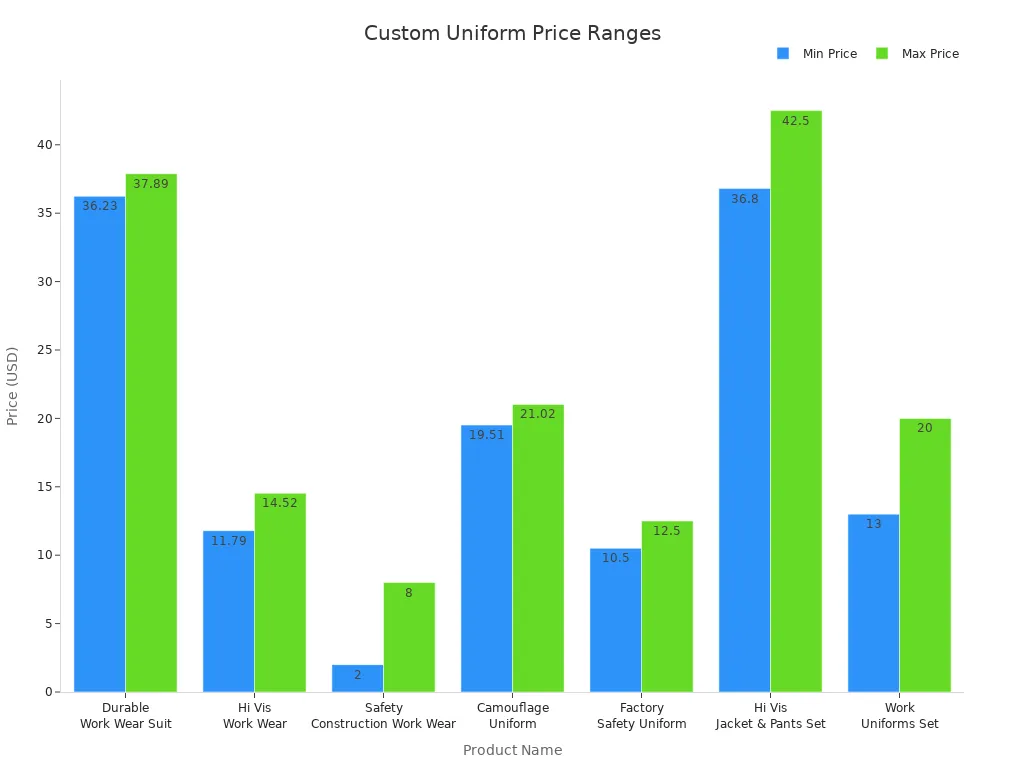
I always remind clients that investing in quality pays off. Cheaper uniforms may save money upfront but often require frequent replacement. I help businesses plan for both initial costs and long-term value.
Maintenance
Proper care extends the life of branded uniforms and protects your investment. I teach teams to follow a few simple practices:
Conduct regular inspections to catch minor issues early and repair them promptly.
Encourage employees to rotate their uniforms to distribute wear evenly.
Provide clear instructions on handling, washing, and storing uniforms.
I also stress the importance of following care labels. Staff should pre-treat stains quickly and wash similar items together. Air drying uniforms, or using low heat when machine drying, helps preserve fabric quality and logo appearance.
Tip: Consistent maintenance routines keep uniforms looking sharp and professional, reducing the need for costly replacements.
By focusing on quality materials, smart budgeting, and proper maintenance, I help clients achieve uniforms that last, look great, and support their brand every day.
Versatile Options
Seasonal Uniforms
I always recommend that clients consider seasonal uniforms as part of their branding strategy. Seasonal uniforms help staff stay comfortable and look professional throughout the year. In my experience, rotating uniforms for different seasons not only improves employee satisfaction but also keeps the brand image fresh and relevant. For example, lightweight polos and moisture-wicking shirts work well in summer, while insulated jackets and long-sleeve shirts provide warmth in winter.
Many businesses benefit from renting seasonal uniforms. This approach offers several advantages, especially for retail environments where staff numbers fluctuate during peak seasons. I often share the following table with clients to highlight the key benefits:
Advantage | Description |
|---|---|
Renting uniforms eliminates the need for large initial purchases, making it budget-friendly. | |
Consistent Cleanliness | Regular cleaning and maintenance ensure uniforms are always fresh and presentable. |
Professional Appearance | Well-maintained uniforms enhance the professional look of staff, crucial for retail settings. |
Scalability | Easily adjust uniform quantities and sizes as staff changes, ideal for seasonal fluctuations. |
Time Savings | Outsourcing uniform management saves internal resources and time. |
Compliance Support | Ensures uniforms meet safety and regulatory standards, important for certain retail environments. |
I have seen how seasonal uniforms help businesses scale up quickly during busy periods. Staff always look sharp, and managers save time by outsourcing uniform management. This flexibility supports both branding and operational efficiency.
Tip: I advise clients to plan seasonal uniform changes in advance. Early planning ensures smooth transitions and keeps the team looking unified all year.
Accessories
Accessories play a crucial role in elevating store uniforms. I often suggest branded hats, lanyards, name tags, and belts to reinforce the brand identity. These items do more than complete the look—they add functionality and boost professionalism. When I introduce branded accessories, I notice that employees feel more connected to the brand and customers find it easier to identify staff.
Here is a table that summarizes the main benefits of adding branded accessories to store uniforms:
Benefit Type | Description |
|---|---|
Functionality | Accessories serve practical purposes, enhancing employee safety and efficiency in their roles. |
Professionalism | They contribute to a polished and professional appearance for employees, boosting customer perception. |
Branding Opportunities | Accessories reinforce brand identity, increasing visibility and recognition among customers. |
I have observed that branded accessories make a strong impression on customers. In fact:
60% of people trust businesses more when staff wear branded apparel.
75% of Gen Z respond positively to branded clothing.
67% of customers say branded uniforms make it easier to identify employees.
These numbers show that accessories are not just decorative—they are strategic branding tools. I always encourage clients to select accessories that match their brand colors and logo style. This attention to detail creates a cohesive look and strengthens the overall impact of the uniform program.
Note: Small touches like branded lanyards or hats can set your team apart and leave a lasting impression on customers.
Getting Started
Supplier Selection
When I begin the process of sourcing custom apparel for a store, I always prioritize supplier selection. The right supplier determines the quality, consistency, and brand visibility of your custom branded apparel. I use a clear set of criteria to evaluate each supplier’s ability to deliver custom apparel that meets my expectations for design, placement, and durability. Here is a table I rely on when comparing suppliers:
Criteria | Description |
|---|---|
Production Capacity | I confirm the supplier can handle my current custom apparel needs and scale up as my business grows. |
Customization Capabilities | I assess their ability to incorporate unique placements, creative logo placement, and specific design requirements. |
Quality Control Processes | I ask about their quality assurance methods to ensure consistent fabrication and logo placement. |
Delivery Reliability | I review their track record for meeting deadlines and maintaining inventory levels for custom apparel. |
Customer Service | I consider how responsive they are and how well they resolve issues related to design or placement. |
Cost Structure | I compare pricing models, including bulk discounts and fees for custom design or placement. |
I always look for suppliers who understand the importance of maximum brand visibility and can execute full front logo placement, left chest logo placement, and sleeve logo placement with precision. The supplier’s ability to offer unique placements and maintain high visibility across all custom apparel is essential for my brand’s success.
Order Process
Once I select a supplier, I move into the order process for custom apparel. I follow a structured approach to ensure every design and placement detail aligns with my brand visibility goals. Here are the steps I take:
Design: I collaborate with designers to create a mockup of my custom apparel. I review every placement option, including full front logo placement, left chest logo placement, and sleeve logo placement. I check that the design supports brand visibility and allows for edits.
Confirm & Pay: After approving the design and placement, I receive an invoice. I complete payment so the order moves into production.
Print & Deliver: The supplier prints the custom apparel and delivers it. I expect a timeline of 3-4 weeks for delivery, depending on the complexity of the design and placement.
During this process, I pay close attention to placement accuracy. I verify that the supplier can execute creative logo placement and unique placements that enhance brand visibility. I always request samples to confirm the quality of the custom apparel and the precision of the logo placement.
Rollout
Rolling out new custom apparel to staff requires careful planning. I focus on best practices to ensure smooth adoption and maximum brand visibility. Here are the steps I follow:
Communicate Expectations Clearly & Early: I establish a uniform policy and use visual guides to explain the purpose behind the custom apparel. I train managers on proper placement and design standards.
Select Apparel That Blends Function, Fit, and Brand Identity: I prioritize fabric quality, durability, and fit. I make sure the design and placement reflect my brand values and support visibility.
Use a Uniform Store to Simplify Sizing, Ordering & Fulfillment: I implement an online platform for self-service sizing and automated inventory tracking. This system streamlines the rollout and ensures every staff member receives custom apparel with the correct placement.
I monitor feedback from employees to refine the design and placement of future custom apparel. I encourage staff to share their experiences with sleeve logo placement, full front logo placement, and left chest logo placement. This feedback helps me improve brand visibility and maintain consistency in every rollout.
Tip: Early communication and attention to placement details make the rollout process smoother and increase acceptance among staff.
Customizing store uniforms with your brand logo delivers real results. I have seen businesses report improved employee satisfaction, enhanced customer perception, and increased brand visibility:
Measurable Outcome | Description |
|---|---|
Improved Employee Satisfaction | Employees feel more comfortable and cohesive in their roles, leading to higher job satisfaction. |
Enhanced Customer Perception | Uniforms create a consistent brand image, positively influencing how customers view the business. |
Increased Brand Visibility | Employees wearing branded apparel promote the brand in various settings, extending its reach. |
To overcome challenges like sizing or cost, I recommend these steps:
Use durable materials for a lasting professional image.
Conduct team fittings to address sizing.
Streamline bulk orders to manage expenses.
Review each step before finalizing your uniforms. Well-designed uniforms inspire pride and set your team apart.
FAQ
What is the best method for adding a logo to store uniforms?
I recommend embroidery for durability and a premium look. Printing works well for colorful, detailed designs. Patches offer flexibility for seasonal or temporary staff. I always match the method to the brand’s needs.
How do I choose the right fabric for custom uniforms?
I select fabric based on comfort, durability, and job requirements. Polyester suits active roles. Cotton feels soft and breathes well. High-performance fabrics work best for outdoor or demanding environments.
Can I customize uniforms for different seasons?
Yes, I advise using lightweight shirts in summer and insulated jackets in winter. Seasonal uniforms keep staff comfortable and maintain a professional appearance year-round.
How do I ensure logo colors match my brand?
I share official color codes (HEX, RGB, Pantone) with my supplier. I request samples before final production. Consistent color matching strengthens brand recognition.
What is the typical turnaround time for custom uniforms?
Most suppliers deliver within 3–4 weeks after design approval. I always confirm timelines before placing orders. Rush options may be available for urgent needs.
How can I involve employees in the uniform design process?
I use surveys or focus groups to gather feedback on fit, style, and fabric. Employee input increases satisfaction and team spirit. I encourage open communication throughout the process.

